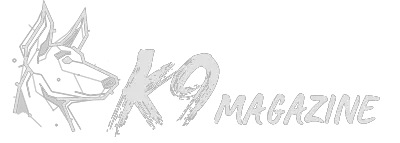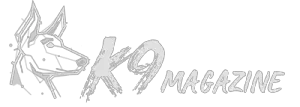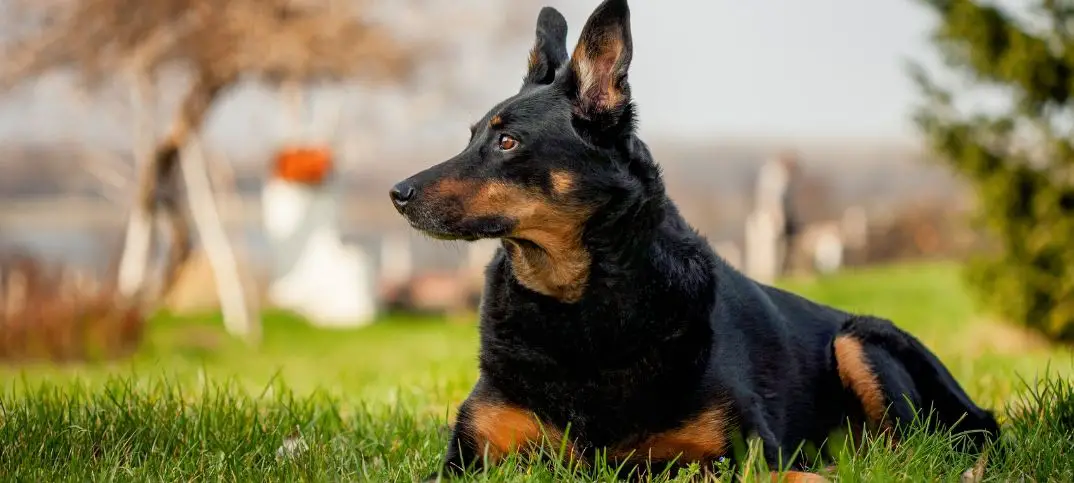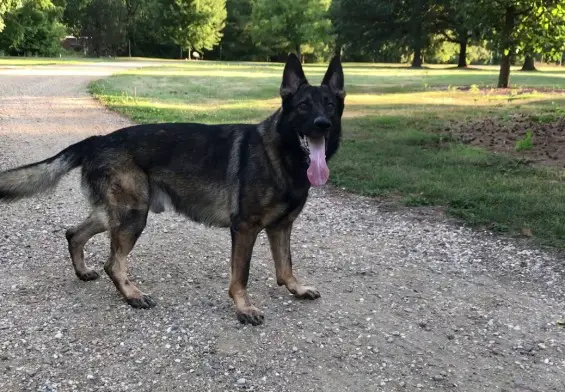Doberman Pinscher German Shepherd Cross Hybrid Mix Dog Breed Guide
Breeders produce Doberman Shepherds by crossing German Shepherds with Doberman Pinschers. Besides their great affection for people, the two species make the most reliable guarding dogs.
Doberman Shepherds love their masters and families and will obediently follow instructions and offer their protection services when needed. The crossbreeds exercise observance and demonstrate their affection to family members and friends despite their intimidating poise.
With crossbreeding comes increased resistance and improved immunity. Doberman Shepherds exhibit robustness and agility throughout their lives and hardly fall sick to common complications affecting their parents.
Discover everything about Doberman Shepherd hybrids as we take you through their character attributes, lifestyles, nutrition, and requirements for their healthy growth and development.
The Origin of Doberman Shepherds
Like many other crossbreeds, the Doberman Shepherd most certainly came into existence in the early 1990s. We’ll conveniently determine the nature and characteristics of Doberman Shepherd crosses by examining both their parents’ traits.
Doberman Pinschers
Doberman Pinschers originally come from Germany, a town called Apolda. In 1890, a levy collector known as Dobermann desired to nurture a loyal dog that could provide protection and company as he traveled to work.
Dobermann mixed different breeds, including Weimaraner, German Pinscher, and Rottweiler, to produce the original Doberman. The Doberman breed became even more famous during the war by providing scouting help to soldiers and acting as a reliable sentry and messenger for troops.
Dog enthusiasts can visit the Doberman necropolis in Guam Island to witness what remains of the Doberman genealogy’s first brave ancestors who helped during the war.
Most people recognize the Doberman Pinscher from its beautiful coat as well as the athletic frame. The AKC added the breed into its organization in the year 1908. Thirteen years later, the breed’s owners and enthusiasts formed their club for Doberman Pinschers.
When standing, a Pinscher measures between twenty-four and twenty-eight inches. The dogs also averagely weigh between sixty and eighty pounds.
The most distinguishing physical traits include the species’ blue, red, or black coatings and their erect triangularly-shaped ears.
Some people used to dock Dobermans’ ears to keep them perpendicular. However, many states and countries currently ban the practice and consider it illegal.
German Shepherds
An in-depth trail will lead us back into the 7th Century when the first German Shepherds ever lived. The breeds served as mountain sheepdogs in Germany by herding flocks for their masters.
Nonetheless, Captain Stephanitz gained all the acclamation for officially nurturing a German Shepherd when he first registered the dog in 1899.
During the late 19th Century, Stephanitz bred various Shepherd dogs in his farmstead and produced a dog that could effectively provide military and patrol duty assistance. The captain registered the first Shepherd under the title German Sheepdog.
Breeders also created an organization around the same timeframe as Stephanitz’s successful discovery to oversee German Shepherd dogs’ proper breeding. The institution intended to develop a good marshaling dog and a hardworking breed.
When The First World War erupted, soldiers and commandants used German Shepherds as war sentinels. Therefore, the AKC changed the breed’s name to Shepherd Dog to sever any Germans’ possible connections.
At the time, the German Shepherd served as the most widely used patrol and army dog in America. In the year 1931, the AKC changed the breed’s name back to German Shepherd.
For a very long time, breeders and keepers in the UK keep referring to the German Shepherd as an Alsatian or Alsatian Wolf Hound.
Breeders classify German Shepherds as large breeds that measure between twenty-two and twenty-six inches in an upright posture and weigh between seventy-five and ninety-five pounds on average.
Shepherds often feature medium double coatings that stay straight on their bodies. Black and tan/red/cream patterns usually accentuate the Shepherds’ straight coats.
GSDs demonstrate strength and energy. A Shepherd’s body features thick and robust thighs, a muscular frame, and a rectangular-shaped body framework.
The hips of German Shepherds tend to incline on their sides or face backward slightly. Most people associate GSDs with wolves because of their erect ears and long muzzles.
The Appearance and Size of a Doberman Shepherd
You can’t mistake the hybrid’s commanding stature with any other crossbreed. Doberman Shepherds possess extremely agile and muscular bodies and big ears that settle upright on their heads.
The crossbreed’s face features an extensive muzzle, a dark-colored nose, and black or brown eyes – their straight and full tails curve slightly towards the end.
Doberman Shepherds will inherit their large size traits from both parents. The large breed will weigh anywhere between forty-one and fifty kilograms and measure between twenty-two and twenty-six inches in height.
Female Doberman Shepherds weigh less and measure slightly shorter than male crossbreeds. Females weigh approximately five kilograms less and reach two inches shorter than males.
At only three months, Doberman Shepherd puppies already weigh as heavy as twelve to sixteen kilograms. Puppies will fully mature when they reach between eight to ten months old.
You can consider your Doberman Shepherds adults when they reach between twenty-four to thirty months old. Female hybrids, however, attain their full sizes faster compared to males.
The puppies’ large sizes can sometimes make it difficult for you to handle them. You should always consider the pup’s size and make proper arrangements to accommodate the big guy before adoption or acquisition.
German Shepherd Doberman mixes enjoy rural farmstead environments that provide ample space for them to play and run freely. The crosses also love homes with large backyards and spacious surroundings.
The Doberman Shepherd’s Coating
Doberman Shepherds’ coatings vary because they only take after the most preponderant traits from their parents. The coats can either look like the shiny and short Doberman furs or resemble the fluffier, wiry, and longer German Shepherd coats.
Typically, Doberman Shepherds possess medium or short length coats artistically highlighted with brown, tan, or black colors, usually with archetypes of all three shades.
Doberman Shepherds don’t shed too much fur – they often experience moderate or low shedding. However, the crosses don’t suffice as perfect companions for persons experiencing severe allergic reactions. You can find out more about Doberman shedding here.
The Personalities of Doberman Shepherds
You’ll undoubtedly end up with an intelligent and muscular hybrid when you cross a Doberman Pinscher with a GSD. Moreover, Doberman Shepherds carry their unique potent and independent strains.
We advise owners to start training their Doberman Shepherds at an early age as this helps in bonding the dog to the master and teaching them to obey their teachers, especially during adulthood.
The crosses will display affection and love once you gain their love, loyalty, and trust. However, Doberman Shepherds sometimes become aggressive and dominant when expressing fondness; we thus suggest that you begin socializing them in their early life.
Shepherd Dobermans can also experience separation nervousness when abandoned for a long time. Due to their fierce character and aggressive early behavior, most critics don’t recommend the Doberman Shepherd for inexperienced owners or families with younger kids.
First-time keepers may encounter many challenges when trying to fulfill the hybrid’s needs. We thus recommend the breed for veteran keepers and families with older children.
The crosses will thrive in outdoor environments, just like their Doberman Pinscher parents. However, the dog won’t do well in colder surroundings like winter. It would be best to keep the hybrid indoors during cold seasons.
Exercise, Grooming, and Nutrition
Properly feeding, exercising, and grooming your Doberman Shepherd constitutes the three main pillars of cultivating a healthy and active dog.
Exercise
Doberman Shepherds reserve lots of energy and thus require ninety minutes of intense activity each day. The dogs will quickly burgeon if placed with an active community that often schedules long jogging or running sessions, dog-park visits, and hikes.
On average, the dog should walk for roughly twelve miles every week.
Their working instincts give Doberman Shepherds the need to accomplish a job or mission. Various gameplays will help in stimulating their minds.
Besides, you can also incorporate obedience teaching in the hybrid’s exercise schedules to keep their minds at their peak functioning. Doberman Shepherds will certainly outshine their rivals in racing and herding competitions.
Grooming
The crosses moderately shed their furs. Besides, the mixes don’t display any hypoallergenic signs. Veteran breeders recommend that owners brush the breed’s coat between three to five times each week. It would help if you also brush the hybrids’ coats only when they get dirty.
Frequently washing the breed can affect their natural oily layers and result in irritating skin. All in all, regular cleaning and brushing will keep the cross healthy.
Breeders nurtured the Doberman Shepherd to become more of a working hound. You won’t require any extra grooming cultures or professional care at the salon.
Nutrition
German Shepherd Doberman hybrids need two feeding sessions of between four and five cups of meal each day because of their large body size.
Vets recommend organic dog meals for the crosses to fully cater to their active and energetic lifestyles. Besides, adding special supplements and vitamins will help significantly in boosting their immunity.
You can always consult the local vet for professional info regarding the best supplement and nutritional options for your canine. While seeking the vet’s help, please don’t shy away from adding various natural constituents to the dog’s regular kibble to improve their fitness and health.
Doberman Shepherds will profit significantly from spineless fish – the boneless protein provides omega-3 and lots of albumens. Fresh fruits and veggies also make nutritional vitamin components.
Because of their part-wolf descent, Doberman Shepherds can quickly flourish when fed raw meat diets. Natural foods contribute to healthier coatings and significantly boost the hybrid’s energy reserves.
The Overall Health of Doberman Shepherds
The mixes originate from a working-class of both Doberman Pinschers and German Shepherds. Naturally, the cross demonstrates resilience, toughness, and very rarely, health problems.
German Shepherd Dobermans will display better health and overall resistance to ailments than their parents because of hybrid vigor’s merits. The crossbreed manifests the superior and most dominant attributes from both progenitors.
However, crossbreeds can still suffer a few health complications. Major health concerns include dysplasia that affects the hips and elbows and cardiomyopathy. Dysplasia often affects GSDs. Cardiomyopathy can also affect German Shepherds.
Bloat, dermatitis, cataracts, and osteosarcoma often befall large breeds, including the Doberman Shepherd. Like many other breeds, Doberman Shepherds’ life expectancy ranges between ten and thirteen years.
The dog’s joints can sometimes wear or tear as they get older. The joints and muscles tire because of the breed’s extremely active lifestyle. Nonetheless, vets advise dog keepers to feed their hybrids omega-3 oils available in fish and Vitamin E.
Acquiring a Doberman Shepherd Pup
Hybrid puppies usually cost roughly $200 to $500 from breeders. When adopting Doberman Shepherd pups, always ensure that you adequately cover their original medical and vaccination costs.
Aspiring owners can spend approximately $500 on purchasing costs. However, annually, dog keepers should anticipate spending an average of $1500 to $2500 on high feeding costs, treatment expenses, toys, and many of their other needs.
Finding the Right Breeder
We often aspire to adopt new crossed puppies from breeders but lack the opportunity to find renowned and trustworthy ones who can guarantee your pups’ safety and health.
Good breeders breed two to three litters of Doberman Shepherd puppies in a year. Ensure you adequately research the breeder and pre-visit the person’s home to examine the puppies’ health situation.
You can easily end up with an unhealthy puppy if you don’t conduct a reconnaissance.
Seasoned breeders skilfully mix Dobermans and GSDs with other dog species to produce reliable watchdog crosses like the German Shepherd Doberman cross.
The following breeders will guarantee safe and healthy puppies:
- Beshara Kennels
- Protection Dog Sales
- Vom Himsmerh German Shepherds and Dobermans
Rescue Centers
The popularity of the GSD and Doberman parents makes it easier for aspiring keepers to find local rescues and shelters for the two breeds.
Besides, the centers also advertise their recently adopted crosses – they’ll inform you of any new arrivalss once you leave your contacts with the organization.
These rescue homes can help you as you begin your search for the perfect Doberman Shepherd pup or adult:
- German Shepherd Rescue and Adoptions
- Sedona Shepherd
- Westside German Shepherd Rescue
- DPCA Rescue
- Doberman Rescue of the Triad
- Dobies and Little Paws Rescue
Conclusion
The overall temperament of Doberman Shepherds varies – sometimes, their protective traits manifest as too aggressively. When adopting the pup, please consider setting more pragmatic expectations.
Before acquiring the pup, ensure that you critically research the breeder to avoid purchasing an unhealthy crossbreed. Visiting breeders at their stations will shed some light on their nurturing cultures and help you determine the puppies’ health condition.
You’ll require extra time, effort, and dedication to properly nurture the Doberman Shepherd into an obedient and loyal crossbreed.
Doberman Shepherds are large breeds that require spacious living environments, frequent training, and lots of nutritious foods.
The hybrids descend from a working class. The dogs can stay active for long and require tiring workout sessions to use up idle energy. Due to their large size, Doberman Shepherds need lots of food to pander to their high activity requirements.
We mostly recommend the species for experienced owners, families with older kids, and homes with lots of free space. Veterans can withstand the toll of consistent training, and spacious homes will provide adequate room for the hybrid to move undeterred and exercise unrestricted.
Always ensure that you don’t miss the scheduled training session because the hybrids need consistency to effectively learn new skills and develop trust and love toward their masters.
We highly recommend the Doberman Shepherd Mix for any enthusiast in search of a ruthless protector as well as a loyal and friendly companion.





